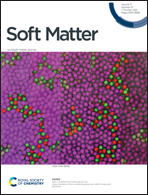Glass transition of ion-containing polymer melts in bulk and thin films†
Abstract
Ion-containing polymers often are good glass formers, and the glass transition temperature is an important parameter to consider for practical applications, which prescribes the working temperature range for different mechanical and dynamic properties. In this work, we present a systematic molecular dynamics simulation study on the coupling of ionic correlations with the glass transition, based on a generic coarse-grained model of ionic polymers. The variation of the glass transition temperature is examined concerning the influence of the electrostatic interaction strength, charge fraction, and charge sequence. The interplay with the film thickness effect is also discussed. Our results reveal a few typical features about the glass transition process that are in qualitative agreement with previous studies, further highlighting the effects of counterion entropy at weak ionic correlations and physical crosslinking of ionic aggregates at strong ionic correlations. Detailed parametric dependencies are displayed, which demonstrate that introducing strong ionic correlations promotes vitrification while adopting a precise charge sequence and applying strong confinement with weak surface affinity reduce the glass transition temperature. Overall, our investigation provides an improved picture towards a comprehensive understanding of the glass transition in ion-containing polymeric systems from a molecular simulation perspective.



 Please wait while we load your content...
Please wait while we load your content...